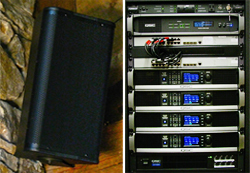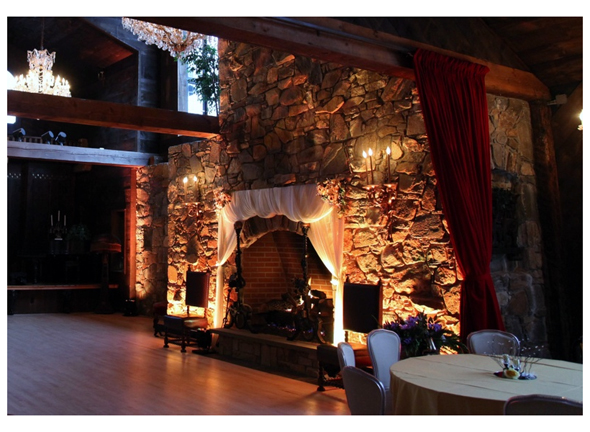
Bill Miller’s Castle, a 24-acre wedding, corporate meeting and special events facility located east of New Haven on Connecticut’s central shoreline, recently completed a major upgrade to its installed sound system.
Design and integration of the venue’s new multipurpose sound system was provided by KJR Engineering of Middletown, CT and includes 38 QSC Audio AcousticDesign and AcousticPerformance loudspeakers installed in 23 zones powered by CXD and CX amplifiers, all controlled by a Q-Sys Core 250i network audio system.
Built in 1880 and maintained by the Millers—a family of renowned gymnasts, acrobats and dancers—since the early 1960s, the picturesque building was initially converted into a gymnastics and dance studio before becoming what was then the first discotheque in Connecticut, the “Sugar Shack.”
The present-day Bill Miller’s Castle now features a large dance floor and multi-level dining areas under three-story cathedral ceilings with leaded stained glass windows and crystal chandeliers, plus balconies, a cocktail bar, buffet and outdoor deck with gazebo.
The new main system has AcousticPerformance AP-5102 2-way loudspeakers on either side of the main stage, plus two GP-212sw subwoofers, to support the bands and DJs that frequently perform at castle events.
The main system is augmented by a series of delay zones utilizing AcousticDesign AD-S8T surface-mount 2-way loudspeakers: one as a mono delay for the lower balcony, two stereo pairs as delay zones in the main room, two more on a mono delay line further into the main room, and one more stereo delay pair for the upper balcony. There is also one more mono pair of AD-S8T in the chapel, with one serving as the main speaker the other as a delay zone.
“The room was a challenge because of the numerous ceiling height changes which required the application of a little EQ and temporal alignment,” reports Bobby Kuhl, president and senior audio engineer with KJR Engineering. “Fortunately, the loudspeakers are all voiced through the CXD amps, which allowed us to take full advantage of the amp’s built-in Intrinsic Correction tunings.”
A main rack houses the Q-Sys Core 250i DSP platform, two CXD4.5 4-channel 2,000-watt amplifiers and a pair of 4-channel 1,400-watt CXD4.3, plus a CX108V 8-channel amplifier for the 70-volt system. “I believe we installed one of the first AD-S8T/CXD combinations in the United States and that we were one of the first installers of the advanced CXD amps,” says Kuhl. “As an early adopter, I did three rooms for Wesleyan University in Connecticut last year using CXD amps. The CXD amps are just terrific.”
A 70-volt system provides coverage of the rest of the facility, including the bar and reception room, which each outfitted with four AD-Ci52ST 2-way ceiling loudspeakers. an AD-S52T surface-mount 2-way loudspeaker in the office; another AD-S52T in one bridal suite; and three more AD-S52T loudspeakers, as main and delay zones for the second bridal suite. The exterior perimeter system includes three AD-S52T loudspeakers.
“The rack in the stage area has a Q-Sys I/O Frame with 16 inputs and a bunch of computer and playback media, including a couple of hard drives,” says Kuhl. A custom patchbay supports I/O for a diverse selection of media, including Blu-ray Disk, DVD, USB, FireWire 800 I/O, HDMI output.
Two portable racks each loaded with a standalone Q-Sys I/O-22 unit, two channels of wireless microphone receivers, a low-power amp for local monitoring and a custom patch panel is linked back via Q-LAN to the Core 250i over redundant Cat6 cables and helps expand the system to 24 inputs.
Kuhl adds that parts of the install required some unconventional approaches. “For example, as part of the 70-volt system we used a ceiling-mount box for the AD-C820 in the gazebo and turned it upside down so that it fires straight up using the roof as a reflector,” states Kuhl. “This allows for very even coverage even at extremely low volumes. To minimize sight lines and improve aesthetics, we painted the can to match the gazebo and mounted it to the cross beam.”
When Kuhl initially toured the facility, Miller family patriarch Jan Miller, explained that he wanted to be able to remotely control the background music during events and whenever he took prospective clients on a walk-through of the amenities.
Using Q-Sys Designer software, Kuhl created a simple UCI for two iPads, one housed in a wall mount next to the system’s power up/down sequencer, and a second, mobile tablet. With that the Millers are able to control the entire system with two IPads and according to Kuhl, “They are extremely happy with the results, Jan texts me weekly with glowing reports from clients and the visiting performers.”

